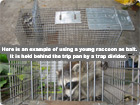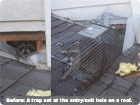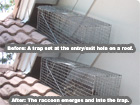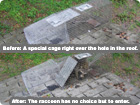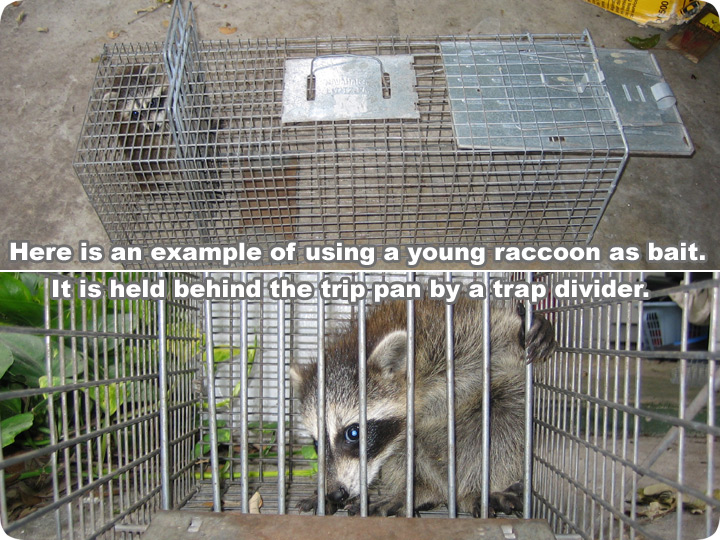
Click the buttons to the left or right for more examples of how the pros set traps in different situations.
In the above photos, you can see that I've set a juvenile raccoon in the back of a trap in order to lure in the mother raccoon. I use a special device called a trap divider to keep the young raccoon in the back of the cage. Be sure to
keep the young raccoon behind the trip pan, or it could set off the trap itself! That's bad, because then the mother raccoon destroys everything in sight while she tries to get to her baby.
If you need professional help, click my Hire A Pro page. I've compiled the USA's best directory of raccoon removal experts.
Will raccoon come back for babies - Most of the time, if the mother has had litters in the past, she will return for her babies. There are reason that she might not; perhaps you scared her badly enough to keep her from returning, or maybe she was an inexperienced mother who lacked established parenting instincts. Aside from those few outstanding circumstances, it’s safe to assume the mother will want to retrieve her young. This maternal instinct can be used against her if you can get to the babies first. By gently removing the litter and placing it in a cage trap, you can leave the trap outside and wait for the mother to return. She will be able to locate the kits immediately by scent, and this will drive her into the trap. Do not leave the babies outside for long periods of time, especially out in the heat or in the sun. If the mother is going to return she will probably come around dusk or just after dark. If a few days go by and you haven’t seen her, it is safe to assume the babies are abandoned. Take them to a wildlife rehabilitator where they can be raised and eventually released.
This is a series of photos of trap sets in the field. These examples are meant to show how professional trap setting looks. The reality is that every case of raccoon trapping is different: number of raccoons, location, type of architecture of the roof or attic they are in, etc. I've done over 1000 raccoon trapping jobs, and every set has been different. There are so many little variables that mean the difference between success and big problems! Trapping is not for amateurs.
If you need professional help, click my Hire A Pro page. I've compiled the USA's best directory of raccoon removal experts.
Will raccoon come back for babies - Most of the time, if the mother has had litters in the past, she will return for her babies. There are reason that she might not; perhaps you scared her badly enough to keep her from returning, or maybe she was an inexperienced mother who lacked established parenting instincts. Aside from those few outstanding circumstances, it’s safe to assume the mother will want to retrieve her young. This maternal instinct can be used against her if you can get to the babies first. By gently removing the litter and placing it in a cage trap, you can leave the trap outside and wait for the mother to return. She will be able to locate the kits immediately by scent, and this will drive her into the trap. Do not leave the babies outside for long periods of time, especially out in the heat or in the sun. If the mother is going to return she will probably come around dusk or just after dark. If a few days go by and you haven’t seen her, it is safe to assume the babies are abandoned. Take them to a wildlife rehabilitator where they can be raised and eventually released.
Click below photos for more examples of trap sets by professionals:
This is a series of photos of trap sets in the field. These examples are meant to show how professional trap setting looks. The reality is that every case of raccoon trapping is different: number of raccoons, location, type of architecture of the roof or attic they are in, etc. I've done over 1000 raccoon trapping jobs, and every set has been different. There are so many little variables that mean the difference between success and big problems! Trapping is not for amateurs.


